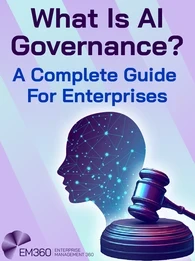
Article contributed by Jason Tooley, VP of North EMEA at Informatica
The hype around artificial intelligence (AI) shows no signs of abating. Seeing the significant value AI holds for organisations, this certainly comes as no surprise. It can revolutionise how businesses operate and interact with customers, automate mundane tasks, boost productivity and much more.
However, AI can only be as smart as the data fed into it. And, without a solid data strategy, AI is likely to be ineffective and unreliable. That’s why a data-driven approach has risen to the top of the C-suite agenda.
A data-driven approach effectively brings data to life, operating as the backbone for every forward-thinking organisation. It accelerates the impact of data and fuels innovation, providing the foundations for a successful AI strategy.
Seeing data as the key to success
How businesses manage and innovate with data can be the decider on whether they become an industry leader or laggard. Many organisations are left overwhelmed by the sheer volume of data available to them. And, combined with siloed processes, this often impacts their ability to extract value from these insights. In fact, our survey of UK Chief Data Officers (CDO) revealed that over half (57%) believe there are more than 1,000 sources of data in their organisation and 31% say this increasing volume and variety of data is one of the main obstacles to achieving their organisation’s data-driven strategy.
When data comes from different sources and is locked in application or organizational silos, it becomes proliferated and fragmented. This makes it harder to gain a comprehensive view of the data assets available and to extract value and execute actionable insights. Data fragmentation not only prevents organisations from developing a truly data-driven culture, but it distorts the view that businesses have of their customers, products and ecosystem – halting business decisions, productivity, and more.
Organisations must look towards a comprehensive data-driven strategy that will help accelerate their business forward. By rethinking how the business understands, stewards and uses data, agile businesses can democratise data across their organisation whilst ensuring proper governance controls remain in place. Data consumers can be empowered to self-serve to meet their use cases so that individual lines of business – from sales to finance – spend less time looking for or understanding data and more time making better decisions using reliable, trusted data. For instance, if HR regularly needs to know how many people have taken sick leave in the last month, a data officer can build a product that makes it easy to access this insight. With this approach, all lines of business have immediate access to accurate insights and trends, meaning they can make better, data-informed decisions.
Steps for success: transforming to become data-driven
However, to reap the rewards of a data-driven strategy, a full business transformation is required. A true data-driven approach is company-wide and driven from the C suite down. Embedding data into the culture of a company requires strong leadership endorsement and the CDO - along with line of business executives - should be accountable to the board or senior executives for its success. To be successful, leadership must demonstrate a commitment to building a data-driven strategy and encourage teams to do the same.
In some businesses, a data-driven transformation may also involve HR. It will require clear communication and engagement to educate teams on data literacy and the value that the data-driven strategy and outcome can create. In time, this will build a culture where data is used and valued, with data innovation fully integrated into company processes.
Collaboration between different departments is also key. It’s no longer about IT solely providing data reporting in isolation on a weekly schedule. Creating a data-driven culture requires close collaboration between all senior leaders, as well as the CDO and Chief Information Officer (CIO). Together, these leaders can transform the operational efficiency of the business, finding ways to leverage data into every function, ensuring organisations are unlocking the true potential from its information sources.
Being able to demonstrate measurable, tangible improvements is crucial too. CDOs should be expected to show the impact data strategies are having on the wider business. For example, by helping reduce customer churn or improve the quality of service delivered to customers or employees.
Seize the opportunity
All in all, a data-driven strategy is the lifeblood of an organisation. However, it is an organisational and cultural change as much as a technology transformation. One that is designed to enable employees at all levels to work with data comfortably and adopt a data-driven mindset that informs decision-making and business outcomes.
Crucially, the data-driven approach serves as a powerful catalyst for businesses to thrive and succeed in the age of AI.
AI depends on trusted data and requires data to be harnessed and made available at the right time. Without a comprehensive, next-generation data strategy, the true value of AI will remain untapped. On the other hand, a data-driven approach will underpin AI capabilities and create innovation. It will ensure businesses can lead the way where data-driven AI adoption becomes the norm, driving change and transforming industries in ways never imagined before.














Comments ( 0 )